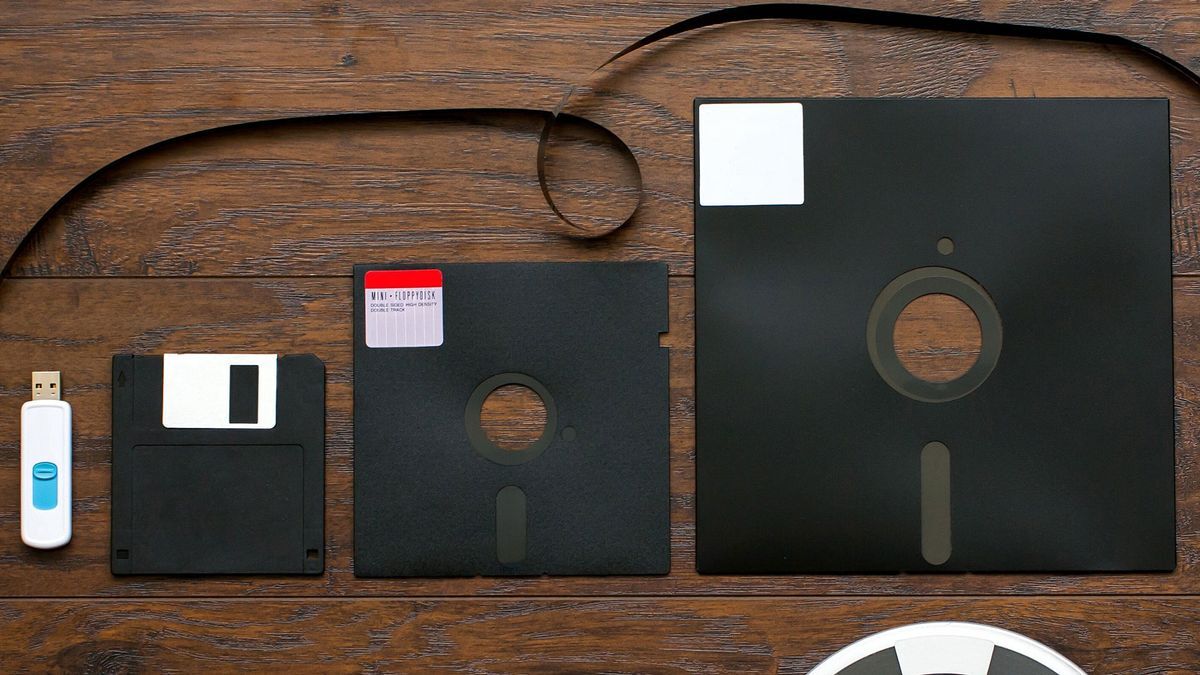The German Navy is searching for a new storage system to replace the aging 8-inch (20cm) floppy disks which are vital to the running of its Brandenburg class F123 frigates. According to an official tender document, the ideal answer to the German Navy’s problems would be a drop-in floppy disk replacement based upon a storage emulation system, reports Golem.de.
Germany’s Brandenburg class F123 frigates were commissioned in the mid 1990s, so it is understandable that floppy disks were seen as a handy removable storage medium. These drives are part of the frigates’ data acquisition system and, thus “central to controlling basic ship functions such as propulsion and power generation,” according to the source report.
It won’t be trivial to replace three decades old computer hardware seamlessly, while retaining the full functionality of the existing floppies. However, we note that other companies have wrestled similar problems in recent years. Moreover, there are plenty of emulator enthusiasts using technologies for floppy emulation solutions like Gotek drives which can emulate a variety of floppy drive standards and formats. There are other workable solutions already out there, but it all depends on who the German Navy chooses to deliver the project.
This is how the retro computer community does it. Instead of trying to keep an aging 30-40 year old floppy or hard drive working, people make all kinds of interface adapters to convert it to be able to use SD and Compact Flash cards. It’s usually something like an AVR or PIC microcontroller that talks to the ancient computer on one end, and interfaces with the newer storage medium on the other, acting as a middleman.
I have a NES cart that does this with ROM files on an external card. As long as you make it speak the old protocol, you’ll fool the machine into thinking it’s using the same old equipment.
It’s hilarious when some of these old machines install OSes like Windows 3.11 in like two seconds with a solid state upgrade.
We had one of those SNES adapter devices that would let you rip a rom from a SNES cartridge onto a floppy disk and use that to boot the game. Worked great with rentals. I wish she wouldn’t have sold it when I was still young because those things were not that common (and super illegal in a lot of countries).
CF cards use the IDE protocol, just in a smaller form factor. Slap one of those bad boys in an ancient PC, and it absolutely flies!
Someone found an old 486 at work somewhere and put it in the junk pile. I pulled it out and did that swap after I accidentally killed the hard drive. It ran like the blazes. It was a little tricky to figure out how to set the CHS values in the BIOS.
Oh snap that’s so geeky cool!
Mid 90s, and they didn’t even use 3.5 inch disks??? Depending on what year, they could have even used zip disks.
Design started in 1989 so I can understand 3.5” was a little too bleeding edge, but 5.25” had been standard for years.
And the 8" were probably the cheapest.
So, as always in government, you get the minimum that satisfies the contract.
Here’s some useless retro crap: the 8" disks almost certainly cost more.
There was absolutely a reliability scale as you moved down the physical disk size: the 8 inch disks were more reliable than the 5.25, which were more reliable than the 3.5, due in large part to the market was requiring them to get cheaper as the drive tech matured, and thus you ended up with cheaper, less reliable media as you went along through the evolution.
40 years later, 8" disks nearly all read, 5.25" disks mostly all read, and 3.5" disks are an absolute crapshoot: I find that less than half of the ones I come across are still actually accessible, compared to about 90% of the 5.25" and 8" ones.
That experience of course has some personal bias, but that’s a story that holds pretty true talking to anyone who tries to archive old floppies, so it’s probably reasonable enough to use for actual data.
So, if you wanted the most reliable option, and since the military probably doesn’t care what it costs, you’d pick a 8" disk.
The old 8” floppy disks were more expensive but known for being incredibly reliable.
The newer 5.25” and 3.5” floppies used cheaper and mass produced coatings on the magnetic surface, plus the smaller and higher density tracks had less surface area per byte and less material to hold the signal.
The net result was the newer floppies often couldn’t be reliably read after a few years of use.
It’s not at all surprising they stuck with the more reliable system for so long.
It might have been selected just for reliability sake. That is how especially militaries usually want them. better to have a tested lesser product of the last gen, than to have the current gen wild card tech that may or may not have a intolerable amount of bugs and problems that could in a combat situation get the ship wrecked and the crew killed.
as always in government, you get the minimum that satisfies the contract.
This is true. That is what you get when you combine governments nearly unlimited budgets with private profit seeking and very little to no oversight. It’s either audit the private contractor in everything all the time or have some state company or institution do the product or service for you.
but 5.25” had been standard for years.
For civilian use but perhaps not in the West German Military. I say West Germany because the ships were ordered in June of 1989 and the Berlin Wall didn’t come down until November.
Europe in general, and Germany in particular, had some very peculiar technology quirks and companies back then.
Edit: It’s worth noting that while the contract was awarded in June of 1988 the ship design was being done in 87/88 which means the targeting system was probably designed in 85/86 when the 8" floppy was still prevalent, especially in Industrial and Commercial applications.
I was system operator for an IBM System/36 in the mid-late 1980s and that thing used two 10-slot magazines of 8" floppies for backup.
It was replaced in 1989 with an AS400 that used half-inch tape.
And that backup solution was replaced with an LTO library.
I graduated college in 1990 and one of the places I interviewed for a job was with the Electric Boat division of General Dynamics. They build the submarines for the US Navy.
During my interview they told me that the computers on the current generation of subs were programmed by punch card. The punch cards were sent to the one contractor that had the ability to convert them to the magnetic tape actually used to load them onto the subs systems.
Perhaps by now they have indeed upgraded from punch cards & mag tape to floppy disks of some sort…
I saw some CNC controllers in the 90’s that were loaded up using paper tape - essentially punched cards but in a tape format.
The admins said they had to load a machine maybe once a year, so no reason to switch to anything else.
These things ran non-stop for years at a time, in a rough environment. They had added some kind of networking (not sure what back then, may have just been a serial connection) so they could send jobs to specific CNC machines using a desktop on the network.
I feel like zip disks would have been a worse investment, so maybe they dodged a bullet here. Those drives were not built to last, and there might actually be more 8" media around than zipdisks these days. IMO, this article would have cropped up a long time ago were that the case.
I believe when talking about naval ships, commissioning is when they enter active service, so construction probably began early 90s, maybe even late 80s, and probably a few years of designing, bidding, etc before that. And of course there were probably all of the usual idiot politicians, bean counters, stubborn assholes, sales people, etc. involved who pushed for older tech. Maybe because everything else they had worked on the old disks, maybe they were skeptical of the new tech not being robust or tested enough or wouldn’t catch on, maybe it was just cheaper, etc.
I’m willing to bet that they somehow locked themselves into using 8 inch disks in the early to mid 80s if not earlier, when the 5¼ discs were still new-ish and the 3½ were brand-new or not even available yet.
I’m willing to bet that they somehow locked themselves into using 8 inch disks in the early to mid 80s if not earlier, when the 5¼ discs were still new-ish and the 3½ were brand-new or not even available yet.
You nailed it. The contract was awarded in June of 1988 and the ship was being designed in 87/88. That means the targeting system was almost certainly designed in 85/86. A time when 8" floppies were still prevalent in Industrial, Commercial, and Military systems.
aging
8-inch
This just in: the German government has classified the Model T as a “classic” automobile
Hey it still works and does it’s job it was designed to do. The problem with driving in a model T is that you can’t easily get a mechanic, manufacturers support or spare parts if something breaks down or you want to like want to install a new modern sound system for example. Like with the floppy disk the real problem is that they can’t upgrade it very easily and make compatible with the upgrades that is ten tech generation ahead of the existing systems, not that it’s old per se.
This is how a lot of military tech is. The radar i used in iraq was using punch codes and a rotating map drum when i was gaming on diablo in my hooch. If it works and is compatible with NATO standards you don’t usually replace it.
There was quite the controversy around the F123 back in the day.
One thing to remember is that “commissioned” means built and on the water. You can see in the Der Spiegel article linked up above that the actual design work on the vessel itself was happening back in 87/88 which means the targeting system was probably designed in 85/86…and now the choice of 8" floppy doesn’t seem nearly so odd.
which are vital to the running of its Brandenburg class F123 frigates
“vital” is overdoing it. It is for some operational status logs.
mid 1990s […] floppy disks were seen as a handy removable storage medium.
They were already considered outdated at that time, but they had a proven record of usefulness and reliability. We can assume that some tests and certifications have counted more than the latest technological features.
What I’d like to know is how the hell do they manage corrosion in all that salty air? Sure, the op centre is probably filtered and air-conditioned, but if there’s one thing about marine environments, salt corrosion will happen, and you can’t put 30 coats of paint on a floppy drive’s components.
I am shocked! Shocked that the Germans aren’t running that shit on bureaucratic paperwork filing instead.
30 year old? 3.5 inch floppies became standard in the middle of the 80s- 5.25 before that. 8 inch came out in 1971, so nearly 55 year old tech.
Do never change a running system!
These systems may already have stopped running due to bitrot, I guess.
Do never change a running system!
No. There are plenty of reasons to change a running system. Spare parts become unavailable, troubleshooting knowledge is becoming lost, and the existing system was terrible and is crowding out better newer systems.
I deal with this attitude way too often.
So they put in a Gotek drive like I did with my retro PC?








